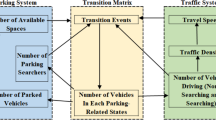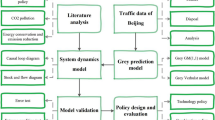Abstract
With ongoing urbanization, traffic congestion and the air pollution it induces are worsening. Using a system dynamics (SD) approach, this study constructed a driving-restriction policy model to explore the effects of different stages of policy implementation on variables such as traffic congestion, emissions, and parking demand. Medium- and long-term dynamic simulation showed that the effect of the policy was obvious in the initial stage but gradually weakened in the medium term, leading to a “fading” effect on traffic-congestion alleviation; a “rebound” effect was even observed at the end of the simulation. Thus, the policy will not effectively reduce traffic congestion in the long term and will induce a new demand for car purchases, resulting in paradoxical effects, which will aggravate parking demand, congestion, and pollution. Yet, it was also found that introducing penalty policies and an air pollution charging fee could weaken the paradoxical effects and compensate for some defects of the policy. Such strategies could help reduce emissions, traffic congestion, parking demand, the number of illegal trips, and the overall number of vehicle trips. These findings can provide not only a theoretical basis for further research but also practical guidance for policy improvement.
Graphical abstract








Similar content being viewed by others
Data availability
All the data generated or analyzed during this study are included in this published article.
References
Bertoldi P (2022) Policies for energy conservation and sufficiency: Review of existing policies and recommendations for new and effective policies in OECD countries. Energ Build 264:112075. https://doi.org/10.1016/j.enbuild.2022.112075
Börjesson M, Kristoffersson I (2015) The Gothenburg congestion charge. Effects, design and politics. Transp Res Part A 75:134–146. https://doi.org/10.1016/j.tra.2015.03.011
Cramton P, Geddes RR, Ockenfels A (2018) Set road charges in real time to ease traffic. Nature 560:23–25. https://doi.org/10.1038/d41586-018-05836-0
Dace E, Muizniece I, Blumberga A, Kaczala F (2015) Searching for solutions to mitigate greenhouse gas emissions by agricultural policy decisions — Application of system dynamics modeling for the case of Latvia. Sci Total Environ 527–528:80–90. https://doi.org/10.1016/j.scitotenv.2015.04.088
Dahim M (2021) Enhancing the Development of sustainable modes of transportation in developing countries: challenges and opportunities. Civ Eng J 7(12):2030–2042. https://doi.org/10.28991/cej-2021-03091776
Dale S, Frost M, Ison S, Nettleship K, Warren P (2017) An evaluation of the economic and business investment impact of an integrated package of public transport improvements funded by a Workplace Parking Levy. Transp Res A 101:149–162. https://doi.org/10.1016/j.tra.2017.04.034
Ding Z, Zhu M, Tam VWY, Yi G, Tran CNN (2018) A system dynamics-based environmental benefit assessment model of construction waste reduction management at the design and construction stages. J Clean Prod 176:676–692. https://doi.org/10.1016/j.jclepro.2017.12.101
Eliasson J (2014) The role of attitude structures, direct experience and reframing for the success of congestion pricing. Transp Res Part A 67:81–95. https://doi.org/10.1016/j.tra.2014.06.007
Esfandabadi ZS, Ravina M, Diana M, Zanetti MC (2020) Conceptualizing environmental effects of carsharing services: A system thinking approach. Sci Total Environ 745:141169. https://doi.org/10.1016/j.scitotenv.2020.141169
Fontoura WB, Gisele D, Ribeiro GM (2018) The brazilian urban mobility policy: the impact in são paulo transport system using system dynamics. Transp Policy 73:51–61. https://doi.org/10.1016/j.tranpol.2018.09.014
Gu Y, Deakin E, Long Y (2017) The effects of driving restrictions on travel behavior evidence from Beijing. J Urban Econ 102:106–122. https://doi.org/10.1016/j.jue.2017.03.001
Guo LL, Qu Y, Wu CY, Wang XL (2018) Identifying a pathway towards green growth of Chinese industrial regions based on a system dynamics approach. Resour Conserv Recycl 128:143–154. https://doi.org/10.1016/j.resconrec.2016.09.035
Hsiao CT, Liu CS, Chang DS, Chen CC (2018) Dynamic modeling of the policy effect and development of electric power systems: a case in Taiwan. Energy Policy 122:377–387. https://doi.org/10.1016/j.enpol.2018.07.001
Hubbell BJ, Kaufman A, Rivers L, Schulte K, Hagler G, Clougherty J, Cascio W, Costa D (2018) Understanding social and behavioral drivers and impacts of air quality sensor use. Sci Total Environ 621:886–894. https://doi.org/10.1016/j.scitotenv.2017.11.275
Jia SW, Liu XL, Yan GL (2019) Effect of APCF policy on the haze pollution in China: a system dynamics approach. Energy Policy 125:33–44. https://doi.org/10.1016/j.enpol.2018.10.012
Jia SW, Yan GL, Shen AZ, Zheng J (2017) A system dynamics model for determining the traffic congestion charges and subsidies. Arab J Sci Eng 42(12):5291–5304. https://doi.org/10.1007/s13369-017-2637-5
Kumar S, Sinha S (2021) Willingness to pay for improvement in service quality of intermediate public transport (IPT) modes. Civ Eng J 7(5):866–879. https://doi.org/10.28991/cej-2021-03091696
Liu P, Liu C, Du JB, Mu D (2019) A system dynamics model for emissions projection of hinterland transportation. J Clean Prod 218:591–600. https://doi.org/10.1016/j.jclepro.2019.01.191
Liu SF (2017) Grey System Theory and Application. Science Press, Beijing (in Chinese)
Liu X, Ma S, Tian J, Jia N, Li G (2015) A system dynamics approach to scenario analysis for urban passenger transport energy consumption and CO2 emissions: a case study of Beijing. Energy Policy 85:253–270. https://doi.org/10.1016/j.enpol.2015.06.007
Liu Y, Yan ZJ, Dong C (2016a) Health implications of improved air quality from Beijing’s driving restriction policy. Environ Pollut 219:323–328. https://doi.org/10.1016/j.envpol.2016.10.049
Liu YX, Hong ZS, Liu Y (2016b) Do driving restriction policies effectively motivate commuters to use public transportation? Energy Policy 90:253–261. https://doi.org/10.1016/j.enpol.2015.12.038
Liu ZY, Li RM, Wang XK, Shang P (2018) Effects of vehicle restriction policies: Analysis using license plate recognition data in Langfang, China. Transp Res Part A 118:89–103. https://doi.org/10.1016/j.tra.2018.09.001
Ma R, Zhang HM (2017) The morning commute problem with ridesharing and dynamic parking charges. Transp Res B 106:345–374. https://doi.org/10.1016/j.trb.2017.07.002
Mei Z, Feng C, Ding W, Zhang L, Wang D (2019) Better lucky than rich? Comparative analysis of parking reservation and parking charge. Transp Policy 75:47–56. https://doi.org/10.1016/j.tranpol.2019.01.001
Ministry of Ecology and Environment (MEE) of the People’s Republic of China: China Mobile Source Environmental Management Annual Report (2021). http://www.mee.gov.cn/hjzl/sthjzk/ydyhjgl/
Ministry of Ecology and Environment (MEE) of the People’s Republic of China: China Mobile Source Environmental Management Annual Report (2018–2020). http://www.mee.gov.cn/hjzl/sthjzk/ydyhjgl/
Ministry of Environmental Protection (MEP) of the People’s Republic of China: China Vehicle Environmental Management Annual Report (2015–2017). http://www.mee.gov.cn/hjzl/sthjzk/ydyhjgl/
Peduzzi E, Baldi MG, Pisoni E, Kona A, Monforti F (2020) Impacts of a climate change initiative on air pollutant emissions: Insights from the covenant of mayors. Environ Int 145:106029. https://doi.org/10.1016/j.envint.2020.106029
Peng HQ, Zhang GW (2017) Traffic development and synthesizing management of megalopolis transportation. J Transp Syst Eng Inf Technol 17(2):1–6. https://doi.org/10.16097/j.cnki.1009-6744.2017.02.001 (in Chinese)
Sahin O, Stewart RA, Porter MG (2015) Water security through scarcity pricing and reverse osmosis: a system dynamics approach. J Clean Prod 88(3):160–1710. https://doi.org/10.1016/j.jclepro.2014.05.009
Shi H, Wang S, Zhao D (2017) Exploring urban resident’s vehicular PM2.5 reduction behavior intention: an application of the extended theory of planned behavior. J Clean Prod 147:603–613. https://doi.org/10.1016/j.jclepro.2017.01.108
Sörensen L, Schlüter J (2021) How do contract types and incentives influence driver behavior? − An analysis of the Kigali bus network. Hum Soc Sci Commun 8:226. https://doi.org/10.1057/s41599-021-00896-6
Tortosa EV, Lovelace R, Heinen E, Mann RP (2021) Cycling behaviour and socioeconomic disadvantage: An investigation based on the English National Travel Survey. Transport Res A 152:173–185. https://doi.org/10.1016/j.tra.2021.08.004
Upadhyay A, Kumar A, Akter S (2022) An analysis of UK retailers’ initiatives towards circular economy transition and policy-driven directions. Clean Technol Envir 24:1209–1217. https://doi.org/10.1007/s10098-020-02004-9
Upadhyay A, Ayodele JO, Kumar A, Garza-Reyes JA (2021) A review of challenges and opportunities of blockchain adoption for operational excellence in the UK automotive industry. J Glob Oper Strateg 14(1):7–60. https://doi.org/10.1108/JGOSS-05-2020-0024
Wang D, Nie R, Long RY, Shi RY, Zhao YY (2018) Scenario prediction of China’s coal production capacity based on system dynamics model. Resour Conserv Recycl 129:432–442. https://doi.org/10.1016/j.resconrec.2016.07.013
Wu K, Chen Y, Ma J, Bai S, Tang X (2017) Traffic and emissions impact of congestion charging in the central Beijing urban area: a simulation analysis. Transp Res Part D 51:203–215. https://doi.org/10.1016/j.trd.2016.06.005
Xiao C, Chang M, Guo P, Chen Q, Tian X (2019) Comparison of the cost-effectiveness of eliminating high-polluting old vehicles and imposing driving restrictions to reduce vehicle emissions in Beijing. Transp Res Part D 67:291–302. https://doi.org/10.1016/j.trd.2018.10.006
Xu YF, Zhang QH, Zheng SQ (2015) The rising demand for subway after private driving restriction: Evidence from Beijing’s housing market. Reg Sci Urban Econ 54:28–37. https://doi.org/10.1016/j.regsciurbeco.2015.06.004
Yuan HP, Wang JY (2014) A system dynamics model for determining the waste disposal charging fee in construction. Eur J Oper Res 237(3):988–996. https://doi.org/10.1016/j.ejor.2014.02.034
Zapata S, Castaneda M, Franco CJ, Dyner I (2019) Clean and secure power supply: A system dynamics based appraisal. Energy Policy 131:9–21. https://doi.org/10.1016/j.enpol.2019.04.028
Zhang W, Lawell CYCL, Umanskaya VI (2017) The effects of license plate-based driving restrictions on air quality: Theory and empirical evidence. J Environ Econ Manag 82:181–220. https://doi.org/10.1016/j.jeem.2016.12.002
Zhao J, Zhang J, Sun L, Liu Y, Lin Y, Li Y, Wang T, Mao H (2018) Characterization of PM2.5-bound nitrated and oxygenated polycyclic aromatic hydrocarbons in ambient air of Langfang during periods with and without traffic restriction. Atmos Res 213:302–308. https://doi.org/10.1016/j.atmosres.2018.06.015
Acknowledgements
We are thankful to the anonymous reviewers. This research was supported by the National Natural Science Foundation of China (Grant No. 11901167), Project funded by China Postdoctoral Science Foundation (Grant No. 2021M690889), Social Science Planning Foundation of Henan Province (Grant No. 2019BJJ038), Science and Technology Innovation Foundation of Henan Agricultural University (grant nos. KJCX2021B04, KJCX2021B05), and Special Fund for Topnotch Talent at Henan Agricultural University (Grant No. 30500646). We thank LetPub (www.letpub.com) for its linguistic assistance during the preparation of this manuscript.
Author information
Authors and Affiliations
Contributions
SJ contributed to data analysis and writing the manuscript, and YL and TF contributed to data analysis.
Corresponding author
Ethics declarations
Conflict of interest
The author has no conflicts of interest to declare.
Ethical approval
This article does not involve the ethical problem.
Additional information
Publisher's Note
Springer Nature remains neutral with regard to jurisdictional claims in published maps and institutional affiliations.
Rights and permissions
Springer Nature or its licensor holds exclusive rights to this article under a publishing agreement with the author(s) or other rightsholder(s); author self-archiving of the accepted manuscript version of this article is solely governed by the terms of such publishing agreement and applicable law.
About this article
Cite this article
Jia, S., Li, Y. & Fang, T. Can driving-restriction policies alleviate traffic congestion? A case study in Beijing, China. Clean Techn Environ Policy 24, 2931–2946 (2022). https://doi.org/10.1007/s10098-022-02377-z
Received:
Accepted:
Published:
Issue Date:
DOI: https://doi.org/10.1007/s10098-022-02377-z




